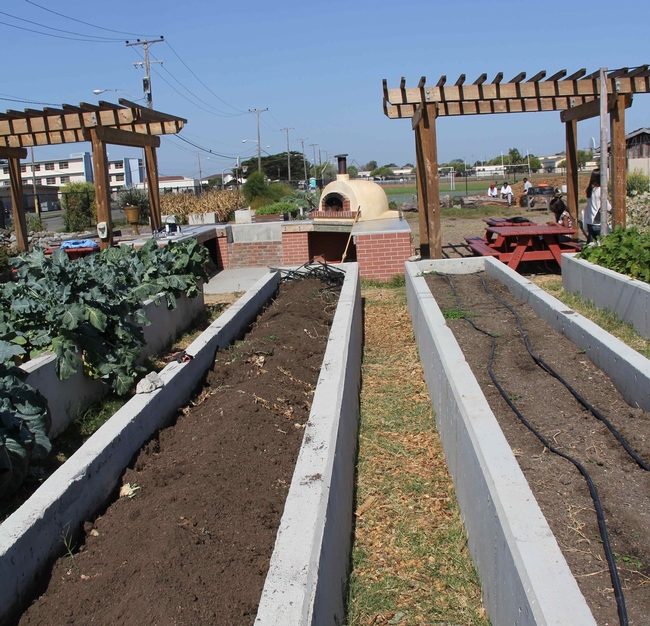Reyna Yagi (ryagi@ucanr.edu), Northern California Urban Agriculture Program Coordinator, University of California Cooperative Extension - Alameda and Contra Costa Counties
Raised Bed Irrigation - Treasure Island Job Corps Farm
How can we as urban farmers do our part to conserve water? Turns out there are a lot of ways that not only will help to save our beautiful state's water, but also help you build a healthier farm or garden with less work on your hands!
The Challenge of Water Access
It's hard to talk about water conservation when many urban farmers run into issues of reliable access to water and affordability of municipal water. Increasingly though, municipalities are working with urban farms and community gardens to offer discounts or grants for water meter and service line installation, help calculate a water budget, and provide a plethora of trainings and resources on efficient irrigation practices and technology. Talk with your local water municipality to see if they have discounted water pricing or special programs (San Francisco is a good
example) aimed at assisting urban farms and community gardens.
Start with Healthy Soils
We know building healthy soils is key for the production and longevity of our crops, but it also allows plants to use water more efficiently and saves you water in the long run. Adding organic matter to your soil increases soil nutrition which helps plants produce better yields and bountiful blossoms without adding more water. Whether sandy or clayey soils, compost reduces the soil's need for water by 30% on average. Top it off with 3-4 inches of straw mulch to further your conservation efforts by keeping soil cool, preserving moisture and reducing weed germination.
Tip Sheet: Building Fertile Soil – Center for Agroecology and Sustainable Food Systems UC Santa Cruz
Know What You Grow
Did you know it takes 33 gallons of water to produce a carrot while almonds require 1,280 gallons (find more facts
here)? Follow seasonal crop patterns - cool season crops will take much more water in the heat of the summer. Once you decide what to grow, choose varieties that are labeled “drought-tolerant” or “widely adapted.” Be sure to group plants by similar plant watering requirements.
Tip Sheet: Your Food Garden During Drought – UC Master Gardener Program Contra Costa County
You Can't Manage What You Can't Measure
Do you know how much water your farm or garden uses? If you use a garden hose, you can estimate your flow rate by timing how long it takes to fill a five-gallon bucket. If it takes five minutes to fill, your flow rate is 1 gallon per minute. If you have an irrigation system and a water meter, it's easy to
read your meter to find out your usage. There are also water gauges one can buy at your local hardware store as well. Keep a record; you may need it later.
Drip Irrigation is Your Best Friend
Drip irrigation is a worthwhile investment that not only reduces your workload, but conserves water by applying it where it is needed most and at a rate conducive to a plant's use. Another benefit for the farmer: it reduces weed growth, helps control mildew plus reduces fungus problems! Drip tape, soaker hoses, micro-sprinklers are among various types of
efficient irrigation products you can use. Install shut-off valves to turn off areas that are fallow. Add an irrigation timer to automate your watering schedule. Controllers can also connect with rain and soil moisture sensors which shut the system off when enough water is applied.
Tip Sheet: Drip Irrigation – Installation and Maintenance – UC Master Gardener Program of Sonoma County
Tip Sheet: For the Gardener - Water Conservation Tips – Center for Agroecology & Sustainable Food Systems, UC Santa Cruz
Other Water Saving Techniques
-
Rainwater Harvesting allows you to capture rainwater from roofs, collect it in a cistern for diversion to your landscape for supplemental irrigation. You should also observe your site's water runoff patterns and see how you can manage and maximize your runoff to deal with large rain events, stormwater runoff and infiltration around your site. Consider a rain garden!
Tip Sheet: Rainwater Harvesting – UC Master Gardeners of Nevada County
- Dry Farming depends on the water stored in the soil from winter rains that plants can use in the spring as the weather warms. Plants rely on good soil moisture and deep roots to seek out this extra water without needing much supplemental irrigation. Grapes, potatoes, tomatoes, winter squash, fruit trees and grains can be dry-farmed.
Tip Sheet: How to Dry Farm Tomatoes in Contra Costa – UC Master Gardener Program – Contra Costa County
And Remember:
- Deep watering wets entire root zones which promotes deeper root growth.
- Always water early in the morning to prevent daytime water loss through evaporation.
- Keep an eye on the weather! A refreshing rain or cool, cloudy day will extend the time between watering.
- Maintenance, maintenance, maintenance. Visually inspect your drip system regularly for breaks, leaks and missing pieces. If you don't, your plants will certainly let you know with plant diseases.
California's agricultural industry is the largest in the nation and abroad, carrying with that a great responsibility to protect and conserve our resources. Urban farmers are highly cognizant of this. They are some of the most innovative and conservation-minded folks out there who understand the fragility of our water supply and their role in being model stewards of our lands and waters.
